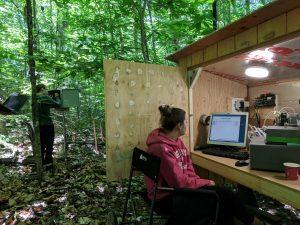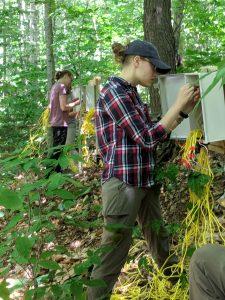Goals and Work

The Center for the Environment’s Watershed Sensing (WatSen) Lab’s goal is to make cutting-edge in situ measurements of watershed hydrology, meteorology, geomorphology, biogeochemistry, and ecology. We produce new understanding of watershed processes and help train the next generation of watershed and environmental sensing professionals as they participate in that pursuit of new knowledge. The lab serves students and faculty from the Applied Meteorology, Biology, and Environmental Science & Policy programs.
We are wiring and coding sensors systems, and building weather-resistant covers that allow us to monitor the environment in any weather conditions. We use open-source sensing platforms when possible. The WatSen Lab is located in Boyd Science Center where we develop our sensors which are then installed in the field. We are well-positioned to make important contributions to the understanding of the micrometeorological and hydrological benefits that forests in our region provide.
The WatSen lab currently focuses on forest micrometeorological projects. The microclimate under forest canopies is strategically important for creating habitat for plants and animals, regulating forest carbon capture, and impacting how water moves through the forest.
Summer 2018

Our technical abilities have made large strides in Summer of 2018. Our student team included Sophia Adams (Applied Meteorology MS, 2021), Rachel Allen (Environmental Science and Policy BS, 2018), Shannon Brunelle (Environmental Science and Policy BS, 2019), and Elizabeth Jurkowski (Applied Meteorology MS, 2020). The project leaders were Eric Kelsey, Mark Green, and Dan Evans. The team pursued four major efforts:
Building a Snow Sensing Station
We prototyped a station for monitoring snowpack depth and temperature using hand-crafted thermistors and other sensors, logged with an open-source data logger (Arduino). These prototypes were used to monitor the snowpack on Mt. Washington the following winter.
Tracing Humidity Under the Forest Canopy at the Hubbard Brook Experimental Forest (HBEF)
We collected water samples for isotopic analysis and operating prototype micrometeorological stations to understand how water vapor is moving in the forest microclimate.
Inventorying the Forest Around the Eddy Covariance Tower at HBEF
This project presented a change of perspective for the team – a chance to focus on the vegetation in the forest that has such a major influence on microclimates. In addition, the team analyzed data from the HBEF tower, which is now a part of the AmeriFlux network.
Monitoring Moisture In and Around a Dead Log at the HBEF
We tested how to effectively monitor moisture in dead wood. This included testing sensors and data logging systems, and also understanding how variable moisture is across large logs. Our motivation for this project was to understand microclimate and its impact on the development of fire hazards.

